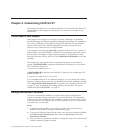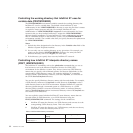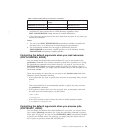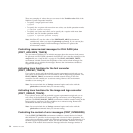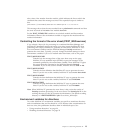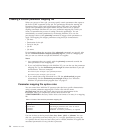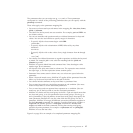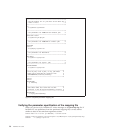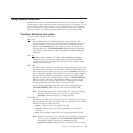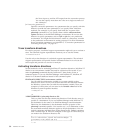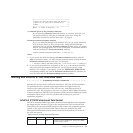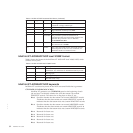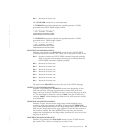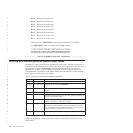
Using transform directives
InfoPrint XT provides a set of internal directives that you can activate to control
certain aspects of the overall data stream conversion process. For example, you can
instruct InfoPrint XT to capture traces of the job data stream as it flows through
the conversion process. You primarily use the transform directives for diagnostic
purposes or when you require special modifications to the transform process.
Transform directives and syntax
You can set these transform directives:
[-a0 | -a1]
For installations that use InfoPrint Manager with InfoPrint XT, this
specifies whether InfoPrint XT captures the InfoPrint Manager document
and job attributes. If you specify -a1, InfoPrint XT writes the directive
output to the jobattr.ipm file in the working directory for the job. The
working directory is %PDXTWORKDIR%\jobs\ServerName_JobIdentifier.
The default is that InfoPrint XT does not capture the InfoPrint Manager
attributes.
[-j0 | -j1]
Specifies whether InfoPrint XT enables online (jes3211) processing of
carriage controls in the job. -j1 enables online processing. -j0 disables
online processing. The default is that InfoPrint XT does carriage-control
processing for online jobs.
[-k0 | -k1]
Specifies whether InfoPrint XT retains the working directory for a job after
the data stream conversion process finishes. The default that InfoPrint XT
uses for the directive depends on how you run the pdxtx2afp command. If
you use InfoPrint Manager with InfoPrint XT and you configure InfoPrint
XT as an InfoPrint Manager configurable transform, the default is -k1.
InfoPrint XT retains the working directory, which is %PDXTWORKDIR%\
jobs\ServerName_JobIdentifier, until InfoPrint Manager removes the job
from the system. If you specify -k0, InfoPrint XT discards the working
directly immediately after data stream conversion finishes.
If you enter the pdxtx2afp command directly, the working directory is
%PDXTWORKDIR%\jobs\jobname-jobID-n and the default is -k0.
Note:
This directive applies only when InfoPrint XT creates the working
directory. It does not apply if you use the -w option of the
pdxtx2afp command to specify a working directory.
[-t
TraceType ...]
Specifies how InfoPrint XT traces a job as it flows through the conversion
process. InfoPrint XT writes all output from the -t directive to the working
directory for the job. Valid values are:
v x2afp.in - Saves a copy of the original Xerox job.
v x2afp.out - Saves a copy of the AFP job generated by data stream
conversion.
v x2afp - Saves both the original Xerox job and the generated AFP job.
Note:
Multiple occurrences of the -t directive are cumulative. For example,
you can specify -t x2afp.in with the PDXTX2AFP_DIRECTIVES
environment variable, and specify -t x2afp.out with the
document-comment attribute. In this case, InfoPrint XT saves both
Chapter 3. Customizing InfoPrint XT 29



